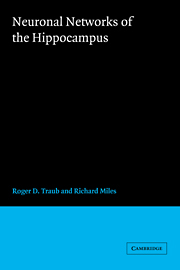Book contents
- Frontmatter
- Contents
- Acknowledgments
- Prologue
- 1 The hippocampus in context
- 2 Physiology of single neurons: voltage- and ligand-gated ionic channels
- 3 Synaptic function and organization of the CA3 region
- 4 The single-cell model
- 5 Model of the CA3 network
- 6 Collective behaviors of the CA3 network: experiment and model
- 7 Collective behaviors of the CA3 network: spontaneous oscillations and synchronized synaptic potentials
- 8 Field effects
- 9 Theoretical approaches: mathematical neural networks
- Conclusion
- Notes
- References
- Index
Prologue
Published online by Cambridge University Press: 05 February 2012
- Frontmatter
- Contents
- Acknowledgments
- Prologue
- 1 The hippocampus in context
- 2 Physiology of single neurons: voltage- and ligand-gated ionic channels
- 3 Synaptic function and organization of the CA3 region
- 4 The single-cell model
- 5 Model of the CA3 network
- 6 Collective behaviors of the CA3 network: experiment and model
- 7 Collective behaviors of the CA3 network: spontaneous oscillations and synchronized synaptic potentials
- 8 Field effects
- 9 Theoretical approaches: mathematical neural networks
- Conclusion
- Notes
- References
- Index
Summary
Our approach to modeling the brain
What makes the brain so difficult to understand? This question has no simple answer. Many aspects of brain structure obviously contribute to its complexity. There are the large numbers of cells that have different shapes and electrical properties. There are the bewildering connection patterns within and between hundreds of nuclear regions. Dozens of neurotransmitters and modulators exist, each with its own repertoire of receptors and synaptic actions. Data on all of these issues are being and will continue to be pursued with tenacity and persistence, yet, in our opinion, there persists a nagging uncertainty as to what underlying principles, if any, are at work in the brain.
Our doubt exists because the function and behavior of the brain are clearly dependent on the simultaneous activities of many, perhaps all, of its elements. How can activity in so many cells be measured and understood when most experimental techniques allow access to only a few? Just as compelling, what conceptual framework is appropriate for thinking about the simultaneous, coupled activities of large populations of neurons?
In this monograph we shall describe our own approach to a small part of this imposing problem. No single aspect of our approach is mysterious or unique, yet the different aspects may provide new insight into the functioning of the mammalian cortex. We are interested in neuronal population activities generated within small networks of cortical neurons.
- Type
- Chapter
- Information
- Neuronal Networks of the Hippocampus , pp. xi - xviiiPublisher: Cambridge University PressPrint publication year: 1991



